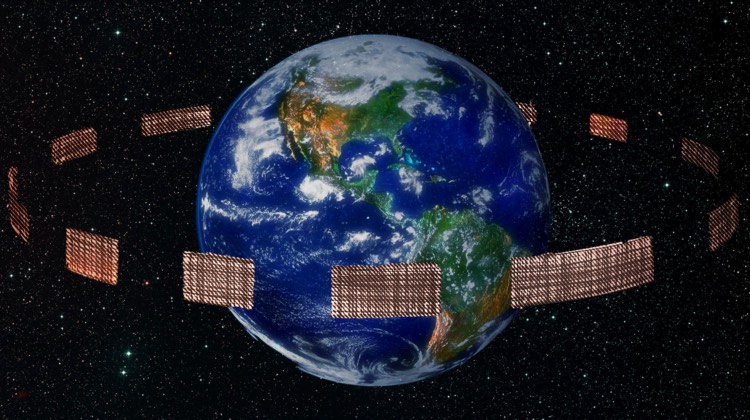Short days—that’s what I wanted. The days in Jasper’s world should be an hour long. How is the topic of this post and the previous one. Why is another story. The previous post described the physics and writerly problems with a quickly-spinning planet. This one describes how Ard’s Girdle of The Gem Merchant’s Son and the godlands of the Clanmarks series came to be.
If the world can’t spin quickly, and ‘just magic’ is too facile, then I needed something to cast periodic shade—sunshades to cause eclipses. I’ll start with the effect I wanted, then work backwards to the cause. Here’s how I describe the effect in the Gem Merchant’s Son:
The day would be a scorcher, and the hourly eclipses welcome. …
At the eastern edge of the world, one of the twelve vast, invisible shield-plates of Ard’s Girdle, rising faster than the sun did, began to nibble into its lower rim. A minute later, the sunlight dimmed and the countryside took on penumbral hues.
On the plateau, the eclipses were quite unlike those he’d known from birth. In the dust and smoke of the city, eclipses were intervals to count the hours by; here, they were a celestial parade to wonder at. When the Arrow drove into a shelter just after shadefall, the sun’s attenuated disk trembled ghost-pale through the occluding shield. The Girdle’s knife-edged rectangles of blackness slid in stately procession across a million stars.
That’s pretty much all the description the novel has for the phenomenon, and the Clanmarks series has little more. Different cultures, different words for the same thing. For example, from book 2 of Clanmarks:
The sunlight dimmed as godshade began. This would be Kron’s shade, the shadow of the floating land of the god of destruction. In a minute, the dusk of the eclipse would fall.
As a fiction writer, I have to describe in-world phenomena from the perspective of the characters who experience them, and that means in a succinct, in-world way. People who live with a common phenomenon won’t dwell on it unless it becomes relevant to the plot. Especially if that person is young, as will usually be the case in YA or MG. To keep a close third or first person perspective natural, the writer can spare few words for everyday phenomena. The character’s incidental experience must be enough to explain them.
What could Ard’s Girdle be? What could cause ‘godshade’? The picture at the top illustrates the idea, though not at all to scale. I imagined Ard’s Girdle to be a space-based megastructure created by the Jasper’s and Petra’s ancestors two thousand three hundred years before their stories begin.
For what purpose, you wonder? Most likely for purposes scientists and engineers discuss seriously today: solar power collection and terrestrial cooling. Working backwards from the timing of the shades in the stories, the panels must be in mid-Earth orbit (MEO), about where GPS satellites are positioned now. That positioning, I’ll admit, is for the convenience of the story: I wanted the shades to appear to the story people to move slowly relative to the Earth’s surface, and an orbit of approximately twelve hours seemed about right. That the ‘panels’ of the structure are not in geostationary orbit does create some engineering difficulties … but those difficulties pale in comparison to the physics problems!
Problems, problems. Where to begin? In no particular order:
Orbital mechanics: A solid physical plate thousands of kilometers wide would straddle many Earth ‘parallels’ (lines of constant latitude). That would be unstable. The gravity of the Earth would pull parts of the plate in different directions. If such a huge structure were solid, it would (a) be impossibly costly to build, and (b) so unstable, it would quickly be pulled apart into a more stable planar ring structure, like Saturn’s rings.
Indeed, a more practical (though still problematic) proposal would be one of those mentioned in this Acta Astronautica paper, which summarizes several ideas for Earth rings for planetary environmental control. Here’s a small illustration of Saturn ring-like ring of small spacecraft casting a shadow on Earth:

Image credit: Star Technology and Research, Inc.
Tidal forces: anything in orbit is subject to orbital deterioration due to the interacting gravitations of the Earth, the moon, and the sun, and anything else up there. These forces would warp and distort the structure, pulling some parts into higher orbits, some into lower orbits.
Solar winds and cosmic rays: space is a hard place. Anything in orbit around the Earth will be bombarded by a fierce, ever-changing wind of charged particles from the sun, and of course harsh light and hard radiation, too. It will be eroded by deep space particles and radiation energetic enough to damage shielded electronics.
Micro-meteorites: debris already in orbit around the Earth and sun buffets and batters anything man-made, coating and corroding surfaces, scouring and pitting them.
Pretty soon, our millions of square kilometers of parasol collectors will degrade, and begin to look something like this fanciful illustration:
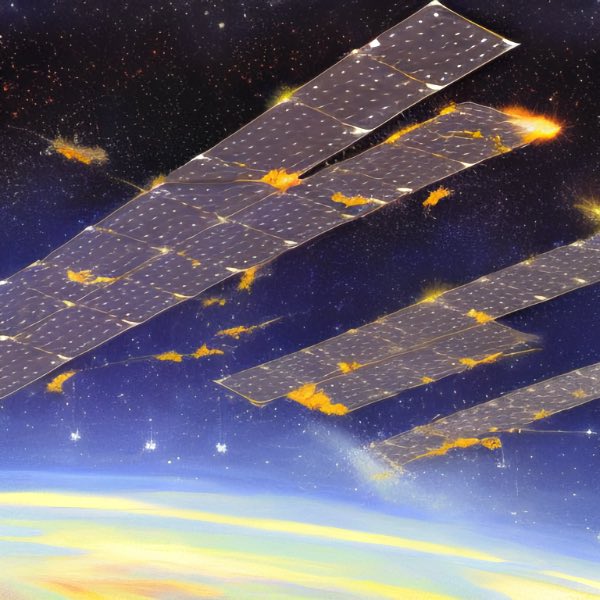
Fanciful depiction of degraded solar panels floating in space
Engineering problems: too many to enumerate. Here are just a few:
- Where to get the construction materials? It would be unreasonably costly and polluting to lift all that mass out of Earth’s gravity well.
- How to resist the forces of deterioration for thousands of years?
- How to get the generated power down to the Earth?
But we are an ingenious specie. We’ve solved difficult engineering problems before. Here’s a sketch of how we might go about solving these problems.
- Use robots to strip-mine the moon for building materials, then throw the materials into orbit using solar-powered rail guns. The moon’s gravity well is shallow compared to Earth’s, so less energy would be needed to move material into MEO from there. There’ve been a number of engineering proposals about how to do this, and the US, China, and the EU are currently making plans for experimental mining operations.
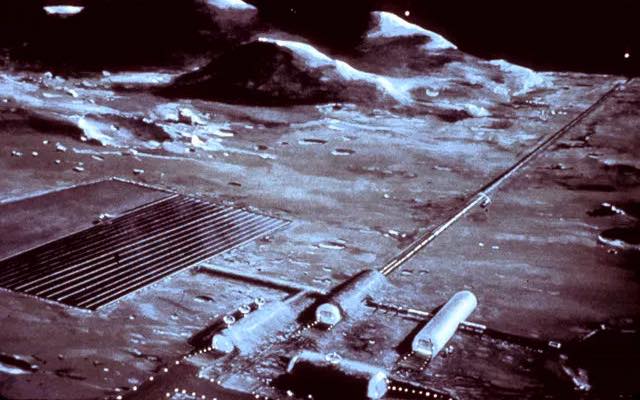
A rail gun on the moon, imagined by the Space Studies Institute
- Design and deploy a self-replicating swarm of small solar collector satellites that can use the solar power they collect to maneuver and change the orientation of gossamer-thin collector/reflector foils. That’s easier written than done, of course. But practical work on all aspects of this vision has been underway for decades, including the hardest part, the self-replicating machine. Small, self-maneuvering satellites could (hypothetically) remain in formation despite the buffeting from solar winds and such, and change their orientation to allow sunlight to pass or to reflect it away from the Earth. Even now, Elon Musk’s satellite company experiments with coatings and maneuvering to make the Starlink satellites less of an eyesore from the ground.
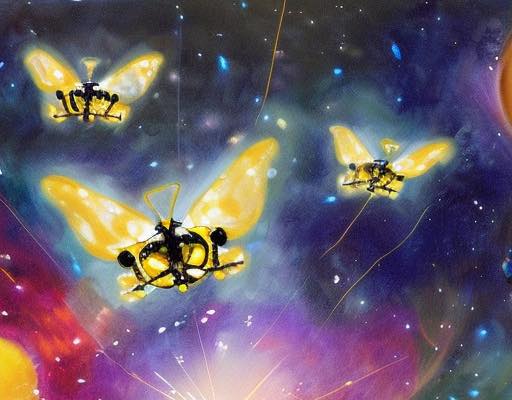
Fanciful fantasy of butterfly satellites
- To solve for the impossibility of a huge flat structure that straddles many parallels, and for the story convenience of giant more-or-less rectangular shadows cast in the northern hemisphere, I combine the idea of a swarm of maneuverable satellites with an orbital configuration that is more flexible than a circular orbit at MEO: a nested elliptical or ‘rolling torus’ orbit. Nested elliptical orbits would support a larger swarm that could (by adjusting thin-film reflector/collector orientation) either block sunlight or allow it to pass to a selectable part of the Earth’s surface. Here an article on Rolling torus structures in astronomy. And below is a not very well scaled illustration of a few satellites in nested elliptical orbits around the Earth. There would need to be billions of them, of course.
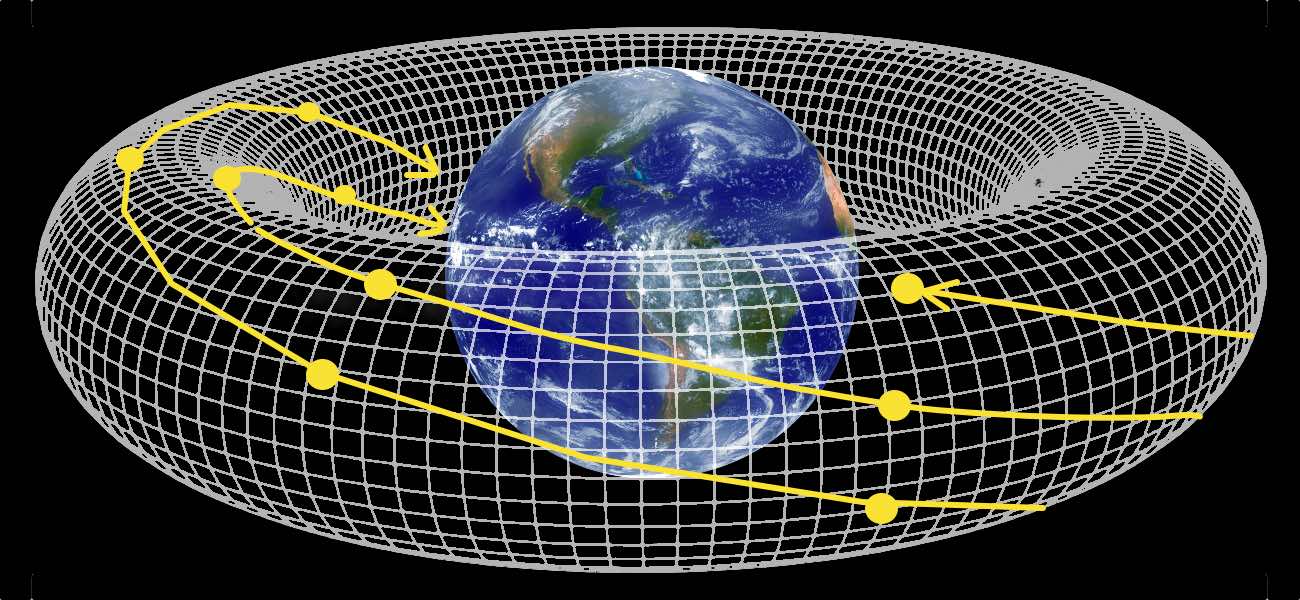
Illustration by the author composed from images borrowed from academic sites.
-
Solutions commonly proposed for getting collected power down to Earth include beaming it in microwaves to large receivers on the surface. But this requires that there by one or more orbiting transmitters that are stationary relative to the Earth’s surface, and the non-stationary collectors would need to transmit power first to them. I didn’t have a detailed design for this, but I did leave an oblique reference to a geostationary artificial moon in The Gem Merchant’s Son.
-
Too much cooling! The cooling effect of the long shades described in the stories would be enough to push the world into a catastrophic ice age. The planet would have to run quite a fever to need such drastic treatment. I do have a backstory explanation–but it will have to wait for a future novel.
So, that’s the vision behind Ard’s Girdle: thousands of millions of solar-powered, self-repairing, self-replicating, self-maneuvering, adaptive satellites with enough swarm intelligence to keep up their Earth-cooling, power-collecting job for millennia after their creators have forgotten why they exist.
For the science-minded: would such a swarm really be the best way to cool the Earth if we’re foolish enough to allow global warming to continue? Probably not. A more practical idea is to position a large refractor or Fresnel lens at the L1 Lagrange Point between the sun and Earth. That idea and others are referenced in the same Acta Astronautica paper mentioned earlier, and in Wikipedia.
To conclude: Some physics problems with this space-based megastructure are worse than with the quickly-spinning world idea, but my A/B experiments with Beta readers tell me that the shades cast by Ard’s Girdle are more palatable than the short days were. In other words, it seems easier for fantasy readers to suspend disbelief with regard to skylands and old tech than to adapt to an unusual length of the natural day. The old tech also dovetails better with the post-post-apocalyptic backstory of the novels.
